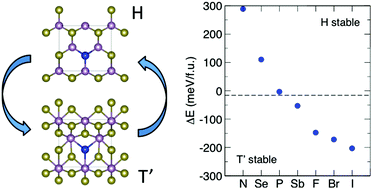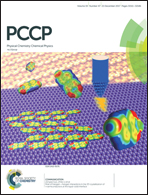Controlling the H to T′ structural phase transition via chalcogen substitution in MoTe2 monolayers†
Abstract
New materials exhibiting reversible structural transitions are desired for a variety of applications, yet they are difficult to identify and stabilize. Monolayer MoTe2 has emerged as a good candidate as it displays a small energy difference between a semiconducting H and semimetallic T′ phase; however, switching between the two phases is difficult. Here, we propose using chalcogen alloying to overcome this challenge. Using first principles density functional theory calculations, we investigate 7 MoTe2−xXx alloys (X = N, P, Sb, F, Br, I, and Se) at three concentrations. We find that the energy difference between the H and T′ phases is dependent on the chemistry, size, and concentration of the dopant atom, providing significant control over the stability of the two phases. From the thermodynamic stability of these compounds, we show that several can be stabilized under the appropriate experimental conditions. We also find that P-alloying enhances the chemical reactivity of the basal plane towards a variety of adsorbates. Finally, we show that mechanical strain makes it is easier to stabilize and dynamically switch between the two states than in unalloyed MoTe2. Our results suggest that Te substitution in monolayer MoTe2 is a way to induce and control a reversible structural phase transition in this two-dimensional material system.



 Please wait while we load your content...
Please wait while we load your content...